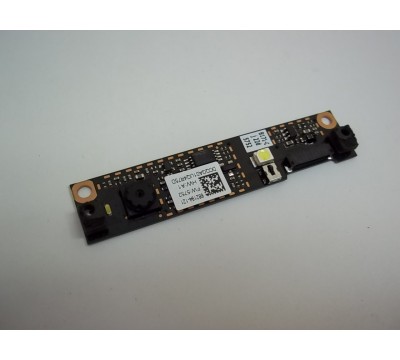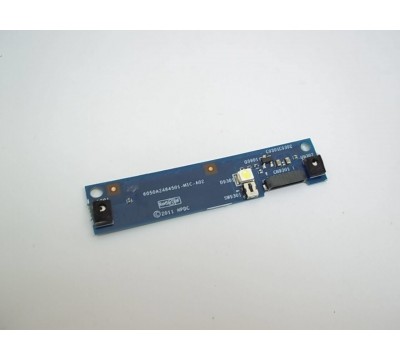
herpmerpderp
-
Posts
10 -
Joined
-
Last visited
Content Type
Profiles
Forums
Downloads
Posts posted by herpmerpderp
-
-
That's right. I noted in my previous reply that you'd need to drill a hole in your non-webcam bezel to give a view out for the retrofitted webcam module OR obtain the bezel designed for the webcam model. Both part numbers are listed in that reply.
If you wanted a webcam that's better than the 720P supplied in the 2570P, then could certain get one as an external USB device. Not as convenient.
Could a better internal webcam be fitted? The issue will be in getting a module with microphone and webcam with the right pinout and size to fit in the bezel. I found that ZBooks use a 720P webcam too so no chance of cross upgrading there. HP probably figure 720p is enough for skype. Interesting to note that the three generations older Elitebook 2530P had a 2MP webcam but the module is way different. A HP CQ42 has a 1.3MP webcam module and it looks more like a 2570P one.
I'll see if I can borrow a drill and file. Just got back and am finally using it! Had to get this since my DTR got stolen.
Upon further inspection, I'm loving the keyboard so far. I noticed that pentalobe screws are being used. Don't know if this is normal or used as an obstacle to hide dodgy defects. Since I don't have a pentalobe screwdriver I can't check just yet. Am I being overly paranoid?
-
Congratulations on an exception buy and welcome to the 2570P Owner's Lounge

INFO: Retrofitting webcam to non-webcam model
I was reviewing the 2570P Maintenance and Support Guide to figure out how to do this.
It looks like retrofitting a webcam can be done relatively easily:
1. Obtain correct display bezel OR drill a hole in the non-webcam one:
For use on computer models equipped with a webcam 685411-001
For use on computer models not equipped with a webcam 685412-001
2. Webcam/microphone module 685413-001 (left) in place of the microphone module 694675-001 (right). You can see they are exactly the same size, have the same input cable it's just that one has the additional webcam on it.


3. Use existing webcam/microphone module cable 685417-001 to attach to the webcam.
If you go ahead in purchasing the webcam module 685413-001 and attempt a fit, then please advise if it's as easy as it seems.
Thanks! I'm still out and about so I haven't had time to take a good look. But the bezel has some sort of indent or cover where the webcam is supposed to be.
But if I'm looking at getting a new bezel along with it, perhaps it would be more sound to buy a decent webcam instead?
-
Hey guys, recently got myself a 2570p in great condition for under 350! Only peeve is that it doesn't have a webcam. Found one on AliExpress for about 20 bucks http://m.aliexpress.com/item/1830079820.html
Do I just have to buy that and fit that in? I'm contemplating on either getting that or just an external webcam.
-
Eventually did. Posted this on the main eGPU thread.
-
M.2 NGFF SSD Compatibility List | My Digital Discount
Just found that piece of information for anyone considering NGFF M.2 eGPU set ups.
-
 1
1
-
-
Just wondering; the NGFF M.2 slots on the Haswell Lenovos, are those the ones compatible with eGPU or has it not been confirmed yet? Just took a look through the manual and I can't find (or missed) any clarification on what the slot supports.
-
I'm curious;
has anybody attempted an NGFF M.2 set up?
-
This all depends on what kind of setup you would be using. If you're able to negotiate an x1 2.0 connection using a nVidia card with optimus, it looks like most people with this configuration are getting ~60-75% or more of the performance of the card. Using higher end video cards typically still results in better performance over using lower end cards but there is some overlap. If you check out the first page of the thread, there is a leaderboard with results from benchmarking. If you're not able to use the optimus configuration or if you can only negotiate a 1.0 connection then your performance will degrade further.
Just to give you a comparison:
Standard Desktop PC (Closest I could find on the 3DMark site with similar processor speed):
Intel Core i7-3770K Processor (3,500 MHz)
GTX 780
3DMark06 Score: 33133
Laptop With EGPU (taken from the first page)
i7-3720QM 2.6 (3,600 MHz)
[email protected] (This is x1 2.0 with optimus configuration)
3DMark06 Score: 25860
Based on just the above, it shows a performance hit of about 28% (if my math is right, otherwise it's 22% @_@) by using the same video card in an eGPU setup with a similar speed processor, but still, that is one of the high-end cards right now and it's still performing very well.
What does that 28% mean to you? If you're able to reach 60FPS with your current video card in a game right now hooked up to a 3.6GHz desktop processor and use that same video card in an eGPU setup on a laptop with a similar 3.6GHz processor, you'd be losing about 17FPS which means you would be down to 43FPS, which is still playable.
Just to throw some wrenches into the gears, it really depends on the game itself how well it would perform with limited bandwidth available. Different amounts of data is transferred at different times based on how the game was programmed, on what is being displayed, and the settings you're using within the game. While we can estimate performance, there's no guarantee that your game will still run flawlessly all the time with slight loss to FPS - you could get stuttering and other strange effects.
This is true. By using the internal display, you're consuming some of the bandwidth the video card would be using to transfer the video data back to the laptop for display. Right now you'll always get better performance using an external display that is connected to the video card.
Ah brilliant, I'm compelled to post to further emphasize my gratitude for making it so clear cut.
Like most people considering the solution, they're after looking for an alternative to maintaining some relative portability and saving some money instead of getting a desktop to supplement the lack of power.
Currently I'm considering a notebook and basing it's viability on a decent balance between portability and eGPU performance for when I'm at home, and the refreshed rMBP 13" with the thunderbolt 2.0 comes to mind. From what I can grasp, it gives the optimal (theoretical) output so that I can get the most out of the intended GPU.
What I don't understand is how the W530 scored more than the rMBP 15" with the same GPU. I thought Thunderbolt has superior bandwidth compared to the other options, e.g in this case, I thought Expresscard < Thunderbolt?
-
Hey guys! I've been following the threads for quite a while now, and I figured I might get a better response here instead of NBR since the creator of that thread is actually here.
So I'm trying to find out the performance hit an eGPU set up would take compared to a desktop.
What I think I get so far, is that output to an external screen gives better results than the LCD. All I'm looking for is optimal performance for an external output. I'm sorry if I phrased the entire post wrongly, I'm still trying to wrap my head around the whole eGPU thing.


12.5" HP Elitebook 2570P Owner's Lounge
in HP Business Class Notebooks
Posted
Thanks for the pointers. This is my first business line of laptops and it feels quite good.
About the 1.3MP webcam part, I'll look into that a bit more with the connectors, unless it's a standard plug and play. Will make my order by the weekend and get back to you if it turns out successful or otherwise.